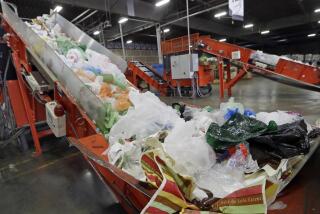Clean-Ocean Issue
- Share via
Your editorial on the San Diego secondary sewage issue (“San Diego Needs to Stick to Guns on Sewage Plan,” July 16) is in an interesting alliance with a piece by James Flanigan on the front page of your Business section (“Environmental Issues Become Big Business”) in which the author discusses environmental business as the next growth industry of the 1990s in which existing laws (and a fleet of environmental lawyers) will be used to enforce an engineering of the environment in the name of clean air and water.
The oceanographic scientific community around the country has questioned the rationality of the Clean Water Act from its inception. The introduction of the waiver process in the late 1970s had the support of the top oceanographers in the world because it allowed a more reasonable case-by-case exploration of not only the state of the effluent, but also the fate of the effluent, which differed widely whether sewage was being disposed into small fresh-water systems of lakes and rivers or into the coastal ocean whose circulation features and bottom topography varied widely from site to site.
The very real fact is that the ocean has served as a receptacle for the organic waste from the continents washed into it from runoff and rivers since the inception of life on Earth. All one needs to ponder is the sedimentary rock that is uplifted in geological formations to view the process, and get a sense of the scale in both time and space.
When the proper scales of space and biological and chemical processes are considered--something that is ill-appreciated in the present climate of folk environmentalism--it is quickly apparent that the mere improvement to sewage effluent by removing up to 90% of the solids rather than 75% of the solids through advanced primary is hardly detectable. The influence is measurable only within a small area around the outfall. What is also known is that these mild effects are reversible and highly local, probably not even having the same scale of environmental impact in the ocean as Lindbergh Field does on the terrestrial ecology.
Does this warrant the expenditure of billions of dollars? I think not, and the scientists, not only from Scripps but elsewhere, have been saying this all along, although not always to a receptive audience, particularly in this climate of environmental business which stands to make billions of dollars profit from taxpayers’ money spent in the name of cleaning up our environmental mess.
The environmental rhetoric right now is such that almost anything done in the name of the environment is viewed as sacred. And, within that climate, elaborate confidence games become possible. I think that it becomes even more important, too, for us to listen to those people whose lives have been devoted to the real study of the ecology of the planet, those scientists from Scripps and elsewhere who have been mostly ignored in a political process around the country heavily influenced by the enormous amount of money that can be made by cleaning up Mother Nature, whether she needs it or not.
ELAINE R. BROOKS
La Jolla
More to Read
Sign up for Essential California
The most important California stories and recommendations in your inbox every morning.
You may occasionally receive promotional content from the Los Angeles Times.













